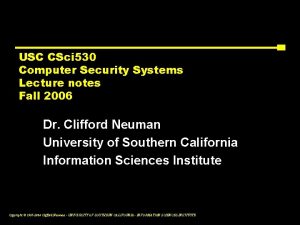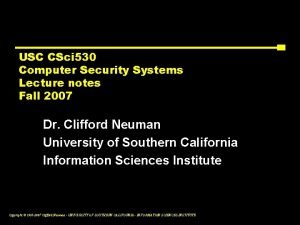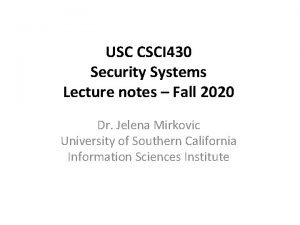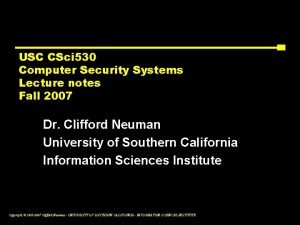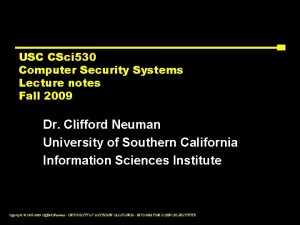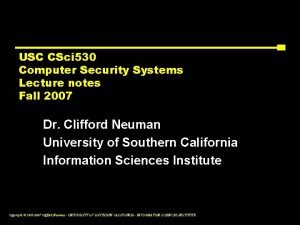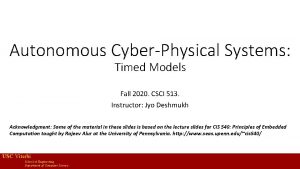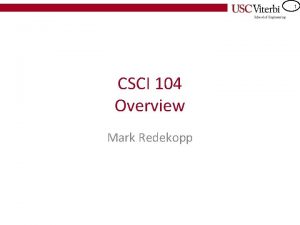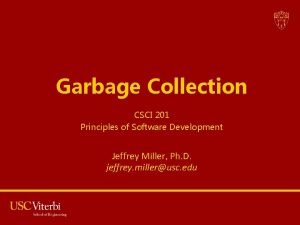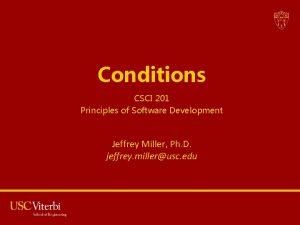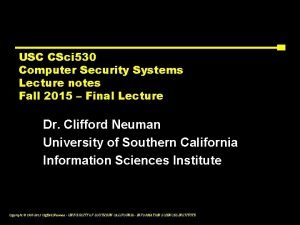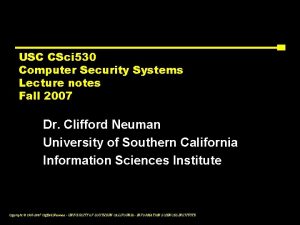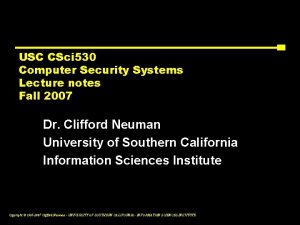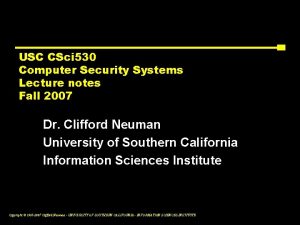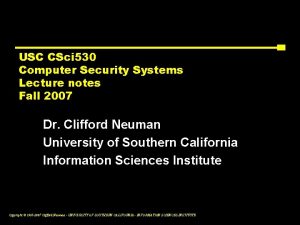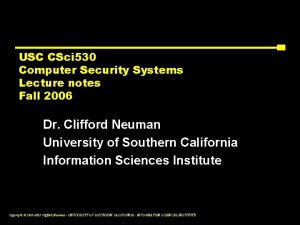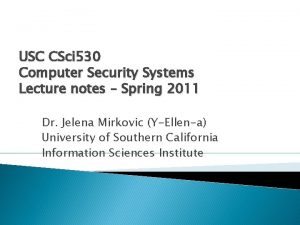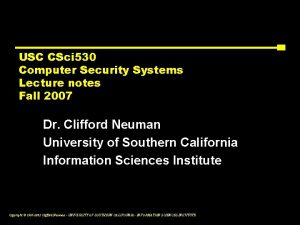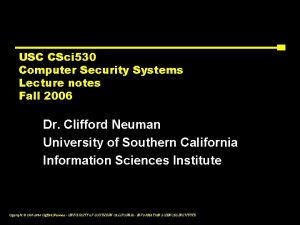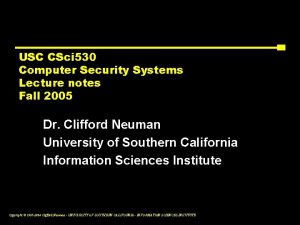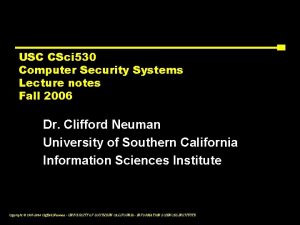USC CSci 530 Computer Security Systems Lecture notes
















- Slides: 16

USC CSci 530 Computer Security Systems Lecture notes Fall 2006 Dr. Clifford Neuman University of Southern California Information Sciences Institute Copyright © 1995 -2006 Clifford Neuman - UNIVERSITY OF SOUTHERN CALIFORNIA - INFORMATION SCIENCES INSTITUTE

Announcements • New course in Spring - Trusted Computing – http: //ccss. usc. edu/599 tc – Friday’s at 1 PM • Final exam – Monday December 11 th at 11: 00 AM – Location SGM 124 (Auditorium) – Bring blank paper – optional stapler • Paper due today – No penalty if submitted/postmarked by 12/8/06 • Course evaluations at break Copyright © 1995 -2006 Clifford Neuman - UNIVERSITY OF SOUTHERN CALIFORNIA - INFORMATION SCIENCES INSTITUTE

CSci 530: Security Systems Lecture 14 – December 1, 2006 Select Topics and Review Dr. Clifford Neuman University of Southern California Information Sciences Institute Copyright © 1995 -2006 Clifford Neuman - UNIVERSITY OF SOUTHERN CALIFORNIA - INFORMATION SCIENCES INSTITUTE

Requested Topics • • Landscape of attacks (glossary) Risk Analysis How are attacks funded? Security Case Studies – I’ll use these as a basis for review Copyright © 1995 -2006 Clifford Neuman - UNIVERSITY OF SOUTHERN CALIFORNIA - INFORMATION SCIENCES INSTITUTE

Glossary of Attacks This is not a complete list • Availability – Denial of Service (Do. S AND DDo. S) ▪ Over consumption of resources – Network, ports, etc – Take down name servers, other critical components ▪ Exploits to crash system ▪ Cache poisoning Copyright © 1995 -2006 Clifford Neuman - UNIVERSITY OF SOUTHERN CALIFORNIA - INFORMATION SCIENCES INSTITUTE

Glossary of Attacks This is not a complete list • Confidentiality – Eavesdropping – Key Cracking – Exploiting Key Mismanagement – Impersonation ▪ Exploiting protocol weakness ▪ Discovered passwords ▪ Social Engineering – Exploiting mis-configurations Copyright © 1995 -2006 Clifford Neuman - UNIVERSITY OF SOUTHERN CALIFORNIA - INFORMATION SCIENCES INSTITUTE

Glossary of Attacks This is not a complete list • Integrity – Breaking Hash Algorithms – Exploiting Key Mismanagement – Impersonation ▪ Exploiting protocol weakness ▪ Discovered passwords ▪ Social Engineering – Exploiting mis-configurations Copyright © 1995 -2006 Clifford Neuman - UNIVERSITY OF SOUTHERN CALIFORNIA - INFORMATION SCIENCES INSTITUTE

Glossary of Attacks This is not a complete list • Miscellaneous – Spam – Phishing – Malware attacks ▪ Spyware ▪ Viruses ▪ Worms ▪ Trojan Horse – Man in the middle Copyright © 1995 -2006 Clifford Neuman - UNIVERSITY OF SOUTHERN CALIFORNIA - INFORMATION SCIENCES INSTITUTE

Risk Management • Security is not absolute • One must balance: – Likelihood of attack – Defense costs – Cost of lost opportunity – Cost on users – Losses from attack • Successful Risk Management – Considers ways to affect all of the above Copyright © 1995 -2006 Clifford Neuman - UNIVERSITY OF SOUTHERN CALIFORNIA - INFORMATION SCIENCES INSTITUTE

Funding of Attacks • Used to be unfunded – Bragging rights • Now networks and underground economy – Organized crime – Direct gain from attack Copyright © 1995 -2006 Clifford Neuman - UNIVERSITY OF SOUTHERN CALIFORNIA - INFORMATION SCIENCES INSTITUTE

Hypothetical Case Studies • Past exams – Electronic voting (Fall 2004) – Medical records (Fall 2003) – Intrusion Detection and Response (Fall 2005) Copyright © 1995 -2006 Clifford Neuman - UNIVERSITY OF SOUTHERN CALIFORNIA - INFORMATION SCIENCES INSTITUTE

Electronic Voting You have been asked to design a system to support the collection and counting of votes for the next election. In particular, you have been asked to design a system that will accurately tabulate votes entered by voters at poling places throughout the state and to transmit those votes to the county clerk of each county where the totals will be tabulated. (a) Threats. What are threats in such a system? What can go wrong? (b) Requirements. What are the requirements for authentication, authorization, assurance, audit, and privacy? Explain who and what must be authenticated, what authorizations are required, what assurance is needed for the software, and what kind of records must be maintained (as well as what kinds of records should not be maintained). (c) Considering the requirements listed above, and how they relate to the assurance problem, i. e. how can steps taken for authentication, authorization and audit be used to ensure that the software has not been modified to improperly record or transmit votes? (d) What technologies proposed for digital rights management be used to provide stronger assurance that the system’s integrity has not been compromised. What is similar about the two problems, and how would such technologies be applied to the voting problem. Copyright © 1995 -2006 Clifford Neuman - UNIVERSITY OF SOUTHERN CALIFORNIA - INFORMATION SCIENCES INSTITUTE

Medical Records • You have been hired as a consultant to advise on the design of a security mechanism that will be used to protect patient data in a new medical records system. This system will manage and support the transmission of patient records, including very large images files for X-rays, MRI, CAT-scans and other procedures. The system must provide appropriate levels of protection to meet HIPAA privacy regulations, and it must allow the access to records needed by physicians and specialists to which patients are referred. (a) Describe appropriate requirements for confidentiality, integrity, accountability, and reliability/availability in such a system. (b) In what part's) of the system (e. g. , where in the protocol stack would you include support for each of the requirements identified in (a)? Why would you place mechanisms where you suggested; what were the issues you considered? (c) What security mechanisms and approaches to implement those mechanisms would you use to meet the requirements in (a) as implemented in the parts of the system you identified in (b)? Copyright © 1995 -2006 Clifford Neuman - UNIVERSITY OF SOUTHERN CALIFORNIA - INFORMATION SCIENCES INSTITUTE

Intrusion Detection and Response • You have been asked to design a system that will provide effective response to new attacks. The system you design will have two components, an intrusion detection component designed to detect attacks, and a dynamic policy enforcement mechanisms that will dynamically adjust policies based on what is learned about attacks from the intrusion detection component. Your system is supposed to provide an effective defense against viruses, worms, as well as attacker targeted penetration attempts to the systems in your organization. Copyright © 1995 -2006 Clifford Neuman - UNIVERSITY OF SOUTHERN CALIFORNIA - INFORMATION SCIENCES INSTITUTE

Review - Topics • • • Cryptography Key Management Identity Management (and Authentication) Policy (and Authorization) Attacks – Classic – The human element • Defenses – Firewalls, Intrusion Detection and Response, Encryption, Tunnels, Defenses to Malware • Architectures and Trusted Computing Copyright © 1995 -2006 Clifford Neuman - UNIVERSITY OF SOUTHERN CALIFORNIA - INFORMATION SCIENCES INSTITUTE

Current Event Could Existing Malware Infect Vista? PC World, November 30, 2006, by Nancy Gohring One security firm says Vista is vulnerable to current threats; another isn't so sure. Microsoft has touted Vista as a more secure version of Windows, but on the day of Vista's official launch, a security company has identified malware already in circulation that can infect computers running the OS. PS: November 30 is “Computer Security Day” first observed in 1988. Copyright © 1995 -2006 Clifford Neuman - UNIVERSITY OF SOUTHERN CALIFORNIA - INFORMATION SCIENCES INSTITUTE
 Csci 530
Csci 530 Csci 530 security systems
Csci 530 security systems Csci430
Csci430 Csci 530 usc
Csci 530 usc Pinstir
Pinstir Csci 530
Csci 530 Csci 513 usc
Csci 513 usc Mark redekopp
Mark redekopp Usc csci 201
Usc csci 201 Csci 201
Csci 201 01:640:244 lecture notes - lecture 15: plat, idah, farad
01:640:244 lecture notes - lecture 15: plat, idah, farad Operating systems lecture notes
Operating systems lecture notes Computer-aided drug design lecture notes
Computer-aided drug design lecture notes Computer architecture notes
Computer architecture notes Computer security 161 cryptocurrency lecture
Computer security 161 cryptocurrency lecture Privat security
Privat security Ece 530
Ece 530
